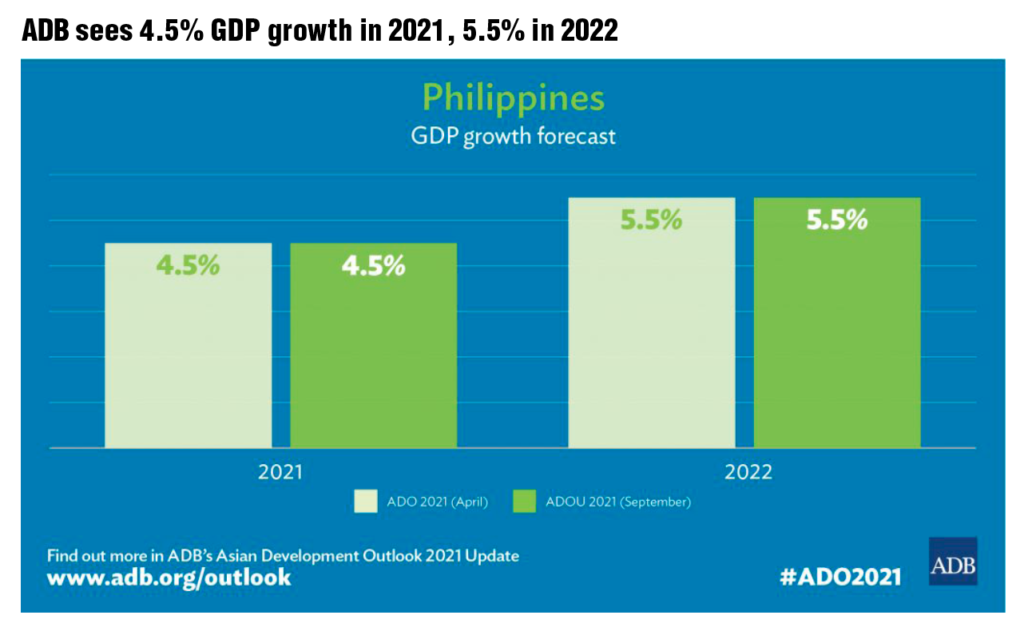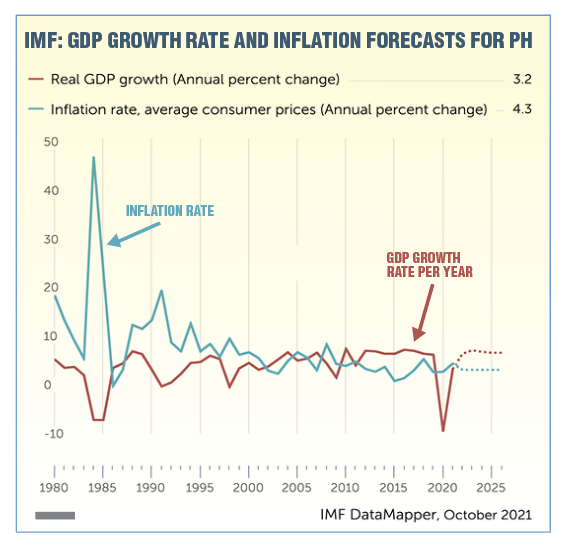The Philippines’ economic growth in 2021 and 2022 will be supported by sustained growth in public infrastructure spending, improving consumer confidence, and progress in the national coronavirus disease (COVID-19) vaccination program, according to a report released Sept. 22, 2021 by the Asian Development Bank (ADB).
ADB maintained its forecast for the Philippines’ gross domestic product (GDP) growth at 4.5% in 2021 and 5.5% in 2022 in its Asian Development Outlook (ADO) 2021 Update.
In contrast, the International Monetary Fund (IMF) is more pessimistic about the Philippines’ economic outlook. It projects real GDP of 3.2% (compared with ADB’s 4.5%) for 2021 and 4% in 2022 (compared with ADB’s 5.5%). See page 40 for ADB projection
Signs of gradual recovery
The Manila-based ADB sees signs of a gradual recovery in the country’s economy, with the upturn in domestic demand and favorable external trends aligned with the ADO’s projections announced in April.
The main risk to the outlook is the spread of newer, contagious COVID-19 variants, which may result in the return of stricter containment measures and stall economic activity, ADB said in a release.
“The economy has regained its footing and is on the right growth path. But the recovery remains fragile due to the threat posed by more infectious COVID-19 variants,” said ADB Philippines Country Director Kelly Bird. “Vaccination remains key to the economy’s safe reopening. We are actively supporting the government’s efforts to achieve its national vaccination targets through our health-related assistance.”
The government has focused on vaccinating Filipinos living in main urban areas such as Metro Manila, which records the highest incidences of COVID-19 cases.
As of Sept. 15, 2021, 84% of Metro Manila residents aged 18 and older, or 8.2 million people, had received at least one dose of a COVID-19 vaccine, and 63% have been fully vaccinated. Overall, as of mid-September, 22 million people nationwide had received a first jab and 17.7 million were fully vaccinated.

Infra disbursements
Public infrastructure disbursements rose 39.1% year-on-year in July, and the government is on track to achieve its target of raising infrastructure spending to at least 5% of GDP in 2021 and 2022, up from 4.8% in 2020.
The economic recovery will be boosted by the government’s policy reforms and expansionary fiscal program, with a fiscal deficit of 7.5% of GDP expected in 2022, the ADB report says.
The National Employment Recovery Strategy adopted by the government in June 2021 focuses on recovery in quality jobs, upskilling workers, expanding social protection and active labor market programs. Among the government’s priority policy reforms are proposed legislations to improve the investment climate.
Inflation 4.1% this year
Inflation forecasts are unchanged at 4.1% in 2021 and 3.5% next year, according to the ADO Update.
With inflation expected to fall back within the central bank’s 2% to 4% target range and a gradual recovery in domestic demand, the government’s monetary policy stance is expected to stay accommodative.
ADB says the country’s current account surplus will narrow to a revised 1% of GDP this year and 0.8% in 2022, with a stronger-than-expected rebound in imports, including for capital goods and raw materials.
A pickup in merchandise exports, as well as receipts from business process outsourcing and higher remittances from Filipinos overseas, will help lift the current account.
IMF’s GDP growth projection 3.2% this year is lower than its 5.4% previous forecast economic growth made in June 2021.
This 3.2% also below the government’s 4-5% full 2021 year target.
The economic slumped by 9.6% in the whole of 2020. NEDA, the National Economic and Development Authority, blames the pandemic and the resulting severe lockdowns for the unprecedented recession.
Economic Planning Secretary Karl Kendrick Chua has predicted that the economic losses of the past two years could have an impact of P41 trillion. To recover that amount, he estimated, it would take 10 years.
President Duterte has imposed the world’s longest and severest lockdown, starting from March 15, 2020 to this writing, in a vain attempt to contain the COVID pandemic.
For his part, Thomas Helbling, division chief of IMF’s Asia Pacific Department, has told newsmen, “the economic recovery in the second half of 2021 is expected to be slower than previously expected, due to a third wave of coronavirus disease 2019 (COVID-19) starting from August and increased uncertainty.”
Helbling blames weaker than anticipated recovery for IMF’s more pessimistic outlook on the Philippines.
Second-quarter GDP grew by 11.8% year on year, bringing average growth to 3.7% in the first half.
P41.4 trillion COVID damage
On Sept. 25, 2021, Economic Planning Secretary Chua estimated the long-run total cost of the COVID-19 pandemic and quarantines for present and future generations of Filipinos at P41.4 trillion, in net present value (NPV) terms.
NPV is an economic concept which measures costs or a stream of assumed revenues giving an imputed cost of money.
The breakdown of the P41 trillion: P4.3 trillion 2020; and P37 trillion in the next 10 to 40 years.
Chua added that consumption and investments are likely to be lower in the next 10 years due to the reduced demand in sectors that require social distancing, such as tourism, restaurants, and public transportation. Consequently, tax revenues will be lower if businesses cannot operate at 100%.
According to him, the estimated total loss due to lower consumption is P4.5 trillion. Meanwhile, the loss in private investment and returns in the same period is around P21.3 trillion.

Years to go back to growth path
“We expect the economy to converge to the pre-pandemic growth path by the tenth year. While we will recover to the pre-pandemic level by the end of 2022 or early 2023, it will take several more years before we converge to our original growth path,” Chua said.
Another key NEDA finding is that workers’ productivity will also be lower due to untimely death, illness, and lack of face-to-face schooling. The impact of these on productivity is likely to be permanent over the next 40 years or the average number of years a person is expected to work in his or her lifetime.
Based on the NEDA study, the resulting productivity loss in human capital investment and returns is estimated at P15.5 trillion for the next 40 years.
Of this amount, P4.5 trillion are losses due to premature deaths, and the loss in productivity from sicknesses and the inability to access treatment from other diseases and illnesses associated with recovery from COVID-19.
Moreover, this also accounts for additional healthcare costs associated with these various diseases
and sicknesses.

Reduction in future wages
Meanwhile, the remaining P11 trillion represents the reduction in future wages and productivity, as a result of the suspension of face-to-face classes in school year 2020 to 2021, and the lost wages of parents who forgo or reduce work hours to accompany their children in online classes.
The loss in future wages is based on the impact of lower quality education from online and other types of distance learning during the pandemic.
According to the Asian Development Bank, every year of lost schooling leads to a 10% permanent decrease in future wages.
Using US data adjusted for Philippine education levels, NEDA estimates that in the Philippines, online and modular learning is only 37% as effective as face-to-face learning. While this tempers the full impact of total school closures, the prolonged use of distance learning will lead to lower future productivity and consequently lower wages.
Cost of school closure in 2020: P230 billion
“The one-year school closure cost the economy P230 billion in 2020, and its impact over the next 40 years of the students’ lifetimes in the labor force is estimated at 10.7 trillion. This impact on productivity is likely to be permanent over the person’s lifetime,” Chua explained.
To address the impact of the COVID-19 pandemic and mitigate the long-term scarring effects on the economy and the people, Chua underscored the importance of the three pillar strategy.
This includes: i) accelerating the vaccination program by expanding vaccination sites and leveraging new technologies, ii) opening the economy safely through localized lockdowns and pilot face-to-face classes, and iii) fully implementing the recovery program, especially the 2021 budget.
“Let us use this pandemic to get everyone to work more urgently to address the problems we have now. Our recommendations have not changed. We can still recover to pre-pandemic level by the end of 2022 or early 2023, with a growth rate of 4% to 5% this year, and 7% to 9% next year, if we do these three things,” Chua assured.
